Microsoft Surface Pro Review
by Anand Lal Shimpi on February 5, 2013 9:00 PM ESTDisplay: Awesome if Calibrated
Surface RT used a 10.6-inch 1366 x 768 display, for Surface Pro Microsoft integrated a full 1920 x 1080 panel of the same size. The increase in resolution is appreciable and you definitely notice it when switching between the two Surface models. Pixel density isn’t class leading, but it’s at least in the right range. On the desktop, Microsoft enables 150% DPI scaling by default which makes everything legible but still a bit odd in applications that don't deal well with fractional DPI scaling. Ideally I would've liked to have seen a clean doubling to avoid this mess.
The higher res display just makes everything sharper in the modern UI, and the 150% DPI scaling in desktop mode makes everything big enough where the higher res isn't a problem there. It's only in those desktop applications that don't properly implement Windows DPI scaling where the higher resolution is a hindrance. I actually ran into this problem using Chrome on the desktop, where my taps wouldn't always map to the right parts of the application (not to mention that Chrome in DPI scaled Windows looks terrible). Thankfully there is always the pen...
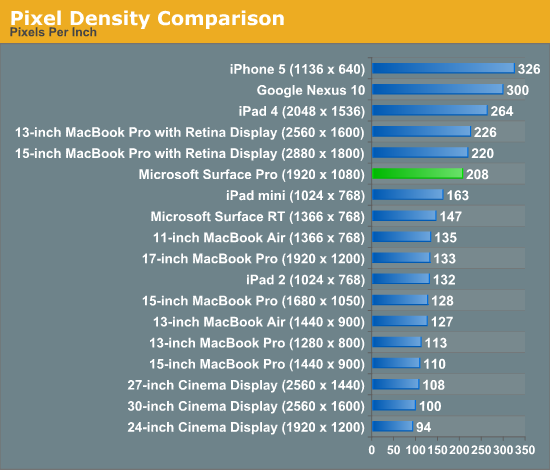
Once again Microsoft doesn’t do any substantial color calibration at the factory, but unlike on Surface RT you can run your own Windows display calibration software on Surface Pro to improve color accuracy if you have the right equipment.
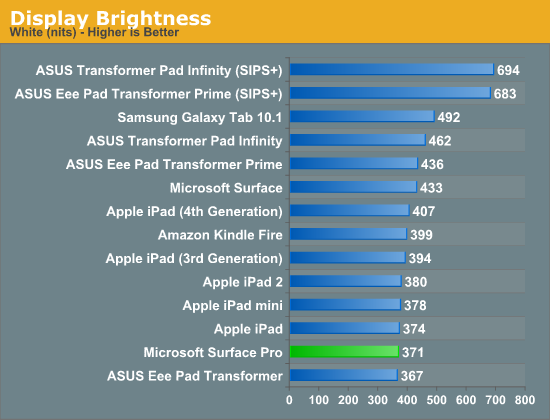
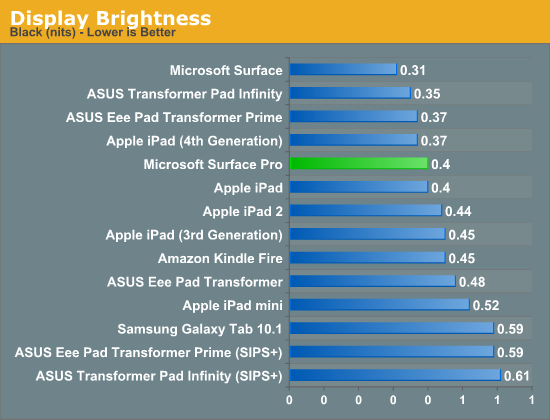
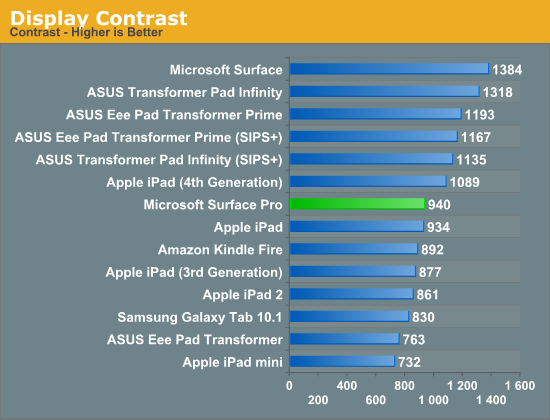
Out of the box my Surface Pro sample had an unusually high white point (~7500K), which negatively impacted its grayscale accuracy. To evaluate color accuracy I turned to our own Chris Heinonen's CalMAN smartphone/tablet workflow. Color accuracy is near identical to Surface RT, which is to say that it’s ok compared to PC notebooks from a couple of years ago but still far behind what you get out of the box from Apple.
Given that the majority of users don’t do any color calibration on their PCs, this becomes a real problem for consumer perception if your tablet doesn’t ship with accurate colors by default.
To see what the panel is capable of I ran it through our standard PC display calibration routine (which I can do since it’s running Windows 8 and is effectively a PC). I then re-ran it through our CalMAN smartphone/tablet workflow and ended up with much more pleasing results. While the display still lagged behind the iPad in one of the tests, it bested Apple’s Retina Display in the other two color accuracy benchmarks.
We'll start off by looking at the calibrated white point for these tablets. What you're looking for here is a number close to 6500K:
The next three charts look at accuracy represented as a difference between various source colors and what's reproduced on the display. The results are presented as average dE2000, with lower numbers being better.
First up is Grayscale performance, here we're looking at the accuracy of black, white and 19 shades of gray spread in between the two extremes:
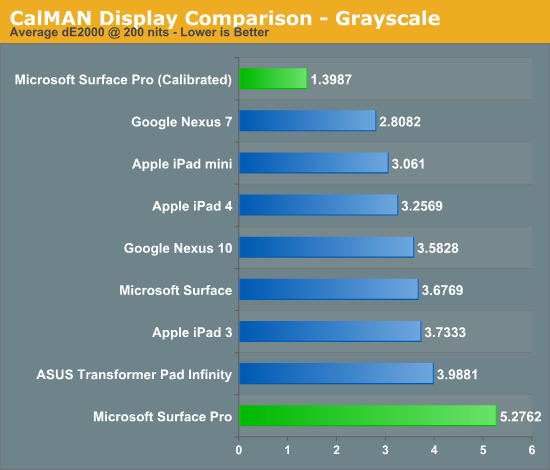
Out of the box grayscale performance is abysmal on Surface Pro. Calibrated accuracy, on the other hand, is just awesome.
First in our color accuracy tests is a saturation sweep. Here we're looking at 20%, 40%, 60%, 80% and 100% saturations of red, blue, green, magenta, yellow and cyan.
Our saturation sweep is the only test where even a calibrated Surface Pro can't match the iPad, it does do a lot better than Surface Pro without any color calibration however. Out of the box Surface Pro is considerably worse than any Apple tablet.
Gamut CIE Chart

Saturation CIE Chart
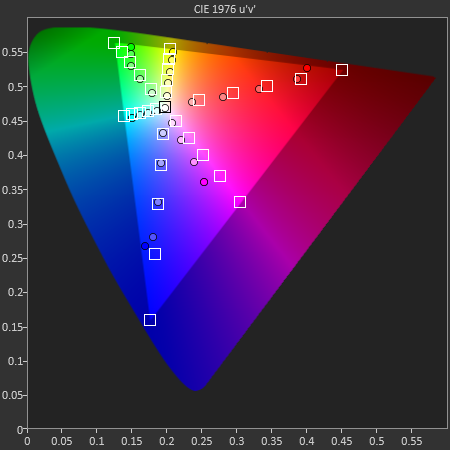
For our final accuracy test we're looking at the difference between a Gretag Macbeth colorchecker chart and the rendered swatches on these displays. Once again, lower numbers are better.
Out of the box Surface Pro and Surface RT are near identical here, and similar to the Nexus 10. With a good suite of calibration tools and supported hardware under Windows 8, Surface Pro has the potential to easily outperform the iPad if given the opportunity.
GMB Color Checker
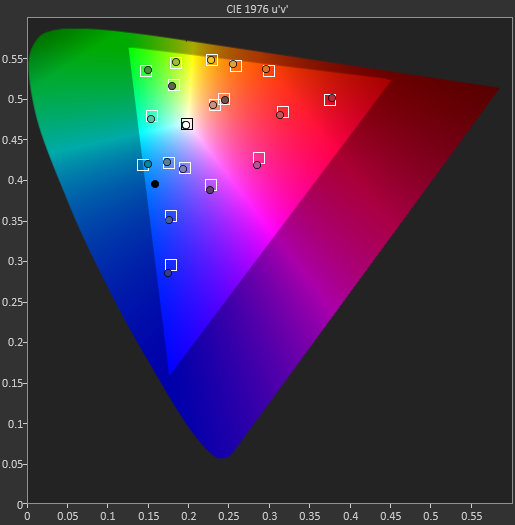
Surface Pro’s panel has real potential, it just needs a calibration pass - which is honestly something Microsoft should be doing these days, not the end user.
Mini DisplayPort but No Thunderbolt
Surface RT featured a single video output in the form of a micro HDMI port. Surface Pro adopts a mini DisplayPort output instead, and will have adapters to enable DVI and HDMI support.
The miniDP output immediately activates as soon as you plug a display into it. I sometimes had issues with display resolutions being set sub optimally, but generally speaking the process was as plug and play as you can get.
I did notice some visual tearing on the Surface Pro display when connected to an external HDMI monitor, similar to what I saw with Surface RT but not nearly as bad. I’m beginning to think something is a bit wonky with Windows 8’s multi-monitor support. What’s interesting is I didn’t see the issue on all displays, which is more than I can say for Surface RT. Update: It looks like this is hardware related. Even if the internal and external panels have the same refresh rate, Intel's HD 4000 won't guarantee that the refreshes will happen at the same time - which is why we see tearing. The tearing should only be present in clone mode, not extended desktop (I'll verify this shortly). It seems like Tegra 3 is worse in this regard, which is why the issue was so much more prevalent on Surface RT. I need to check other Ivy Bridge platforms and under OS X to see if the problem is as prevalent there as well.
The only disappointment here is Microsoft opted against integrating Thunderbolt into Surface Pro. I feel like Thunderbolt would’ve made a ton of sense in a device like Surface Pro, enabling one cable connection to both an external display and high-speed external storage. Given that Thunderbolt adoption remains fairly limited in the PC space I don’t think this is a huge loss for most of Microsoft’s target customer base, but I do feel like it’d be a good way of future proofing the device. The alternative that Surface Pro offers is the combination of miniDP and USB 3.0, which realistically speaking is probably good enough for most users. From a cost of integration standpoint vs. the number of users who would pay for it, it probably didn’t make sense for Microsoft to include Thunderbolt in Surface Pro, but that doesn’t change the fact that I wish it was there. It’d be nice for Apple not to be the only company really pushing Thunderbolt.
Camera Quality
Surface Pro, like Surface RT before it, features two integrated 720p cameras with no flash. Admittedly I didn't spend a ton of time taking photos with Surface Pro but imaging quality is just really bad compared to what you'll get out of an iPad 4. The results are borderline ok for use on the web but that's pretty much it, and forget about decent low light performance.


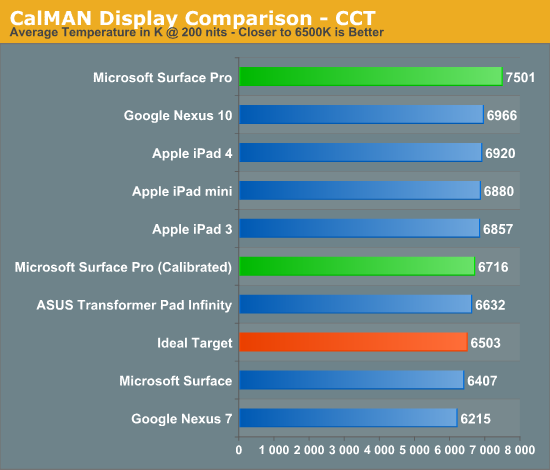
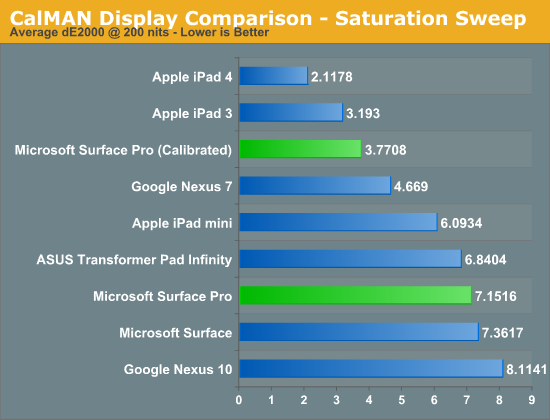
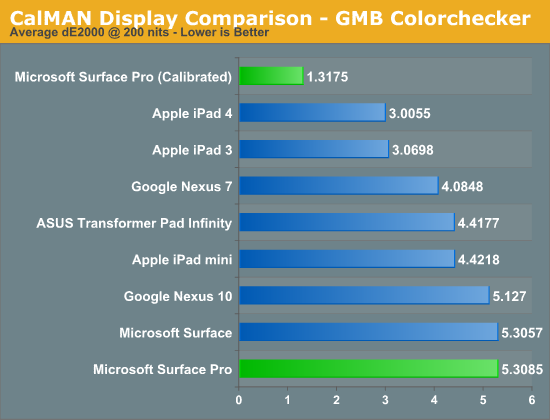










228 Comments
View All Comments
powerarmour - Thursday, February 7, 2013 - link
I think you are missing the point...This is a Windows x86 product we are talking about here, something that we know will eat it's own disk space in temporary files and other junk.
Android and iOS are a 'lot' more frugal when it comes to data usage.
finbarqs - Wednesday, February 6, 2013 - link
I don't know what to expect... But it seems collectively, the surface has more bad reviews than good. In fact, anand wasn't even gung-ho about the device for the first half of the review. In fact, there are just the mentions of the limitation of what the surface is.So let's get one thing out of the way: battery life. average life I've read around the net is 3.5-4 hrs for regular usage -- which is probably worst than the yoga pad. Now i'm just thinking... doesn't the mbp have longer battery life then this? isn't the technology out there yet?
The surface would've been a different story if it had better battery, and came out with data plan enabled -- your favorite LTE carrier. This will make people turn heads more. I was excited to get one this weekend, but I've been put off by all the negative press...
Netscorer - Wednesday, February 6, 2013 - link
What did you expect from Ivy Bridge based design where battery has to be squeezed in the 10" tablet? I am actually quite surprised the battery results come in as high as being reported. 6 hours of browsing - that is very acceptable. 5 hours of video streaming is better then most ultrabooks on the market.nathanddrews - Wednesday, February 6, 2013 - link
This is a topic that I wish would get more attention. I've noticed screen tearing on nearly every Windows 7 and Windows 8 laptop when outputting to an external display, whether cloning or closing the lid. It doesn't seem to matter whether it's Intel, AMD, or NVIDIA graphics hardware or whether HDMI or VGA is used. Doesn't matter if hardware acceleration is enabled in the browser, the game, or video player, the tearing still occurs. The presence and application of Vsync doesn't seem to affect it either.The only consistent symptom is that it is sometimes worse than other times. I suspect that Windows desktop composition is to blame in some way, but I can't prove it.
dragonseer - Wednesday, February 6, 2013 - link
I was waiting for the surface pro, but decided to get the Vaio Duo 11 instead because of a few extra connection options, such as ethernet, HDMI, and I appreciate the backlit slider keyboard... Sporting the same processor and complete with a stylus, I was a mystified by your closing statement that "If you’re shopping for an Ultrabook today and want that tablet experience as well, Surface Pro really is the best and only choice on the market." ???Krysto - Wednesday, February 6, 2013 - link
How many times did you redo your battery tests before you got those results, Anand?You usually get lower battery results than everyone else. But now you got some of the highest, while everyone else puts it at like 4h, at most.
$1,000 for a device full of compromises, and thick and heavy as well is not worth it.
tipoo - Wednesday, February 6, 2013 - link
I find myself wishing the Surface design team would make a proper ultrabook. It could still be a tablet with a flip back screen like the Lenovo Yoga, just make the form factor an actual ultrabook rather than a tablet with a stand. That way they could integrate a better keyboard and mouse and potentially have a bit more room for battery and cooling.smalM - Wednesday, February 6, 2013 - link
"Once again, with lower power hardware I see Microsoft being able to minimize this - but that’s a topic for Surface 2 Pro."And it will have to compete with the successors of iPad 4 and Nexus 10.
"If you’re shopping for an Ultrabook today and want that tablet experience as well, Surface Pro really is the best and only choice on the market."
That's a really small market place.
BSMonitor - Wednesday, February 6, 2013 - link
Except, Ipad and Nexus can NEVER match a Microsoft tablet in one HUGELY important area for IT professionals, etc etc...x86 compatibility
Dekker - Wednesday, February 6, 2013 - link
> x86 compatibilityTrue, but that brings us to the core question: Is x86 compatibility a killer feature? I'm not convinced. Two reasons:
1) Given that x86 software relies heavily on a keyboard and mouse, it is hard to see how the tablet form factor is going to work. Stuff like building spreadsheets and editing large documents is just torture on a tablet (I have tried and tried). I immediately grab my laptop or MBA.
2) I use my tablet for browsing, email, casual gaming, light photo editing and internet shopping. All of these are easily done with apps, none of which require much investment in time, money or file conversion. In short, x86 is an irrelevance for many types of usage.
While I could see some future for the PRO as a corporate tablet, the lack of LTE/3G must surely be a deal breaker for many.